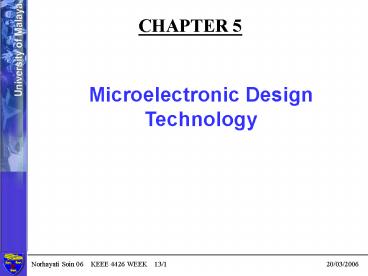Microelectronic Design Technology - PowerPoint PPT Presentation
1 / 22
Title:
Microelectronic Design Technology
Description:
Application-Specific IC (ASIC) or Field- Programmable ... ~1000 10,000 gates per chip, 80 s Very large-scale integration (VLSI, ~10,000 100,000 gates ... – PowerPoint PPT presentation
Number of Views:296
Avg rating:3.0/5.0
Title: Microelectronic Design Technology
1
CHAPTER 5
Microelectronic Design Technology
2
Integrated Circuits (ICs)
- Integrated Circuit (IC) chip
- General-purpose microprocessor, CPU.
- Application-Specific Instruction Set
- Processor (ASIP), e.g. video processor
- or digital signal processor.
- Application-Specific IC (ASIC) or Field-
- Programmable Logic Device (FPLD).
3
Integrated Circuits (ICs)
- IC package contains
- silicon chip die
- Pins, wires between die and pins
- Figure from Application-Specific Integrated
Circuits, Smith, Addison-Wesley, 1997 - Package may have heat sink attached
4
History of Integration
Small-scale integration (SSI) 10 gates per
chip, 60s Medium scale integration (MSI)
1001000 gates per chip, 70s Large-scale
integration (LSI) 100010,000 gates per chip,
80s Very large-scale integration (VLSI,
10,000100,000 gates per chip, 90s Ultra
large scale integration (ULSI) 1M10M gates per
chip
5
History of technology
Bipolar technology and transistortransistor
logic (TTL) preceded metal-oxide-silicon (MOS)
technology because it was difficult to make
metal-gate n-channel MOS (nMOS or NMOS) the
introduction of complementary MOS (CMOS) greatly
reduced power
6
Abstraction levels
7
Gate Transistor Level
8
Silicon Level
9
Applications of ICs
- Home
- Appliances, intercom, telephones,
- security system, garage door opener,
- answering machines, fax machines,
- home computers, TVs, cable TV tuner,
- VCR, camcorder, video games, cellular
- phones, sewing machines, cameras,
- exercise equipment, microwave oven
10
Applications of ICs
Office Telephones, computers, security
system, fax machines, copier, printers,
pagers Automobile Air bags, ABS, instrumentation,
security system, transmission control,
entertainment system, climate control, keyless
entry, cellular phone, GPS
11
Applications of ICs
Micro-Electro-Mechanical Systems - MEMS
Integration of mechanical elements, sensors,
actuators, and electronics on a common silicon
substrate through microfabrication technology.
The electronics are fabricated using integrated
circuit (IC) process sequences (e.g., CMOS,
Bipolar, or BICMOS processes), the
micromechanical components are fabricated using
compatible "micromachining" processes that
selectively etch away parts of the silicon wafer
or add new structural layers to form the
mechanical and electromechanical devices.
12
Applications of ICs
13
Applications of ICs
14
Applications of ICs
15
Applications of ICs
16
Applications of ICs
17
Implementation choices
There are a number of options available to the
CMOS chip designer as to the final implementation
technology, which in order of increased design
investment are off-the-shelf programmable
logic semi-custom gate array semi-custom
standard cell full custom the choice will
affect the design process
18
Implementation choices
19
ASIC
ASIC Application Specific Integrated
Circuit An ASIC is an IC for a specific
application (generally) Produced in relatively
small volumes
ICs are made on a wafer. Circuits are built up
with successive mask layers. The number of masks
used to define the interconnect and other layers
is different between full-custom ICs and
programmable ASICs
20
Full Custom Design
With full custom design we have access to the
design of the individual transistors that make up
our circuits.
21
Standard Cell Design
This technique uses a set of predefined blocks (
adders, multiplexers etc). This is less flexible
than full custom, but it is possible to get
parameterised standard cells which allow some
flexibility in terms of shape and size of the
cell.
22
Programmable Design































